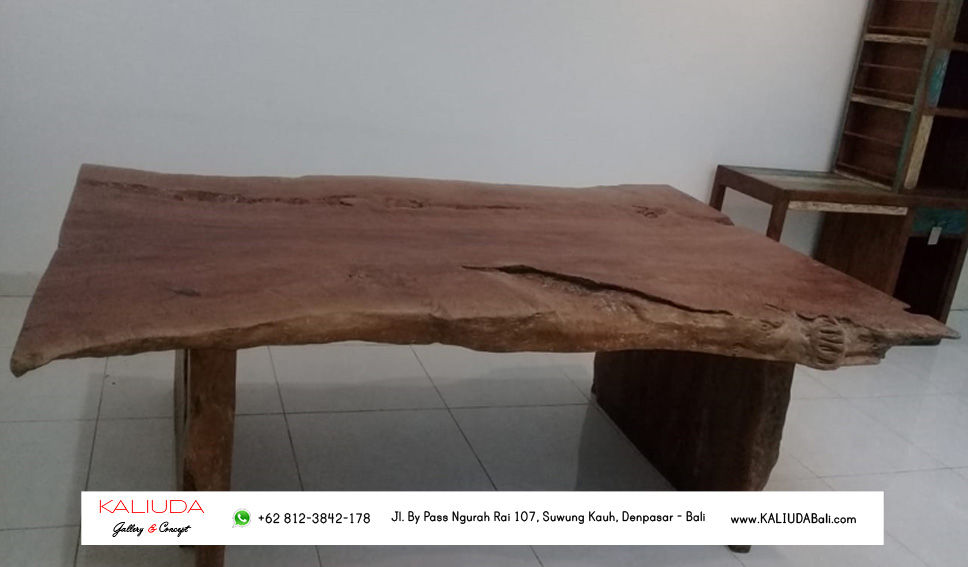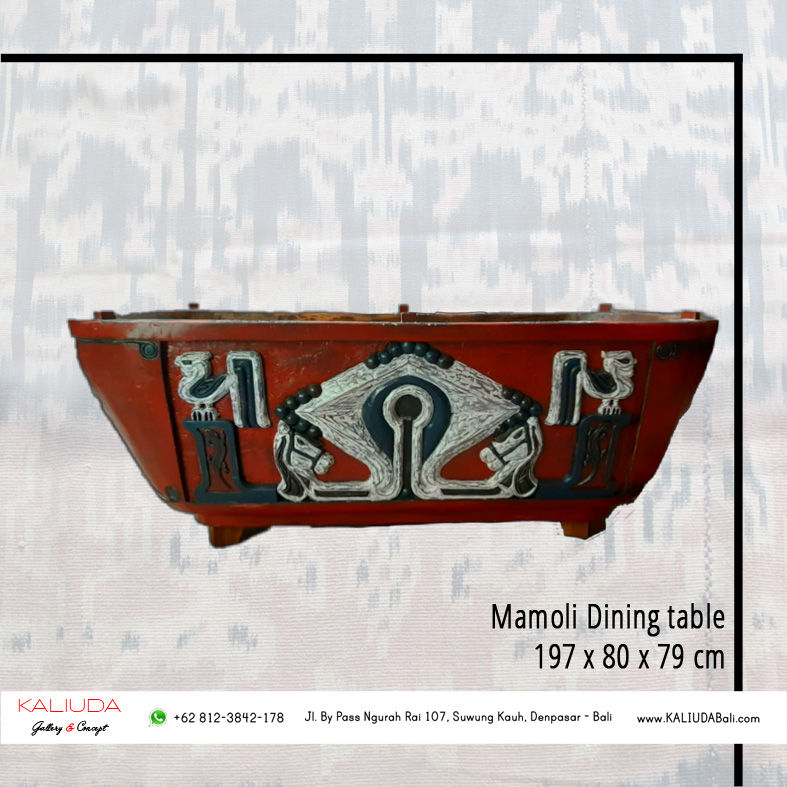8 Types of Wood and Their Characteristics
- KALIUDA Gallery

- May 15, 2019
- 5 min read
Updated: Jul 15, 2019
Wood is the most needed material in everyday human life. One of the uses of wood is as a basic material of furniture making. In Indonesia, there are many types of wood. However, in this post, we will discuss the types of wood that are often used as materials for making furniture in Kaliuda Gallery.
Longan wood (Kayu Lengkeng)
Rain tree wood (Kayu Trembesi / Kayu Suar)
Mahogany wood (Kayu Mahoni)
Acacia wood (Kayu Akasia)
Coconut timber (Kayu Kelapa)
Jackfruit wood (Kayu Nangka)
1. Teak Wood (Kayu Jati)

Teak wood (Tectona grandis) is a tropical hardwood widely used for furniture, especially in Java, Indonesia. A Teak tree can grow up to 40 meters high with a diameter of up to 1,5 meter. The leaves of a teak tree are oval with sizes of 15 to 45 centimeter. Small white flowers with a nice smell grow on the tree. The color of teak wood is somewhere between brown and gold. As the wood dries and ages the color will become more dark.
The older the wood the better the quality, the cross section of the board is also more stable. The possibility of shrinkage, cracks or curves can be minimized with the use of wood that aged. The denser the fiber, the older it means the age of the wood, which means the better the quality.



2. Bornean Ironwood (Kayu Ulin)

Kayu Besi or also known as Kayu Ulin (Eusideroxylon zwageri) It is native from Brunei; Flores, Java, Kalimantan and Sumatra in Indonesia; the Sabah and Sarawak states of Malaysia; and the Sulu Archipelago of the Philippines. It is threatened by habitat loss. Indonesian Government and the state government of Sarawak have formally banned the export of this species. Illegal smuggling continues to be a major problem.
Eusideroxylon zwageri grows in lowland primary and secondary forest up to 625m altitude. It prefers well-drained soils, sandy to clay-loam, sometimes limestone. It is commonly found along rivers and adjacent hills. It requires an average annual rainfall of 2,500–4,000 mm. It occurs scattered or in groups.
3. Longan wood (Kayu Lengkeng)


Longan trees (Dimocarpus longan) can reach 40 m high and stem diameter up to about 1 m. Depending upon climate and soil type the tree may grow to over 100 feet (30 m) in height, but it typically stands 30–40 ft (9–12 m) in height and the crown is round.
The Longan tree produces light-yellow inflorescences located at the end of branches. The inflorescence is commonly called a panicle and are 4–18 in (10–46 cm) long, and widely branched.
The Longan tree is somewhat sensitive to frost. Longan trees prefer sandy soil. While the species prefers temperatures that do not typically fall below 4.5 °C (40 °F), it can withstand brief temperature drops to about −2 °C (28 °F).
4. Rain Tree wood (Kayu Suar / Kayu Trembesi)

Rain tree or Trembesi or Suar wood (Samanea saman) originally lived in South America and now naturally also lives in tropical weather. Naturally it can reach growth to a height of 25 meters and a diameter of 30 meters.
The color of the wood surface: the porch is dark (usually dark brown has black stripes) while the porch is white.
Weight of wood: trembesi wood including heavy wood species, as well as acacia wood or teak wood. According to indonesianforest.com, the average density of this trembesi wood is 0.60, which means it is quite heavy.
Durability: Trembesi wood including wood species with a class IV durable rate
Strength level: for the level of wood strength, trembesi wood is a type of wood with a strong level of class III.
5. Mahogany wood (Kayu Mahoni)

Mahogany is a much sought-after wood, based on its hardness, resilience and beauty. It is commonly regarded as the world's leading wood for fine-quality furniture, cabinetry, sculpture, carving, interior trim and other applications.
Features : The mahogany tree can reach more than 150 feet in height and 6 feet in diameter. Its bark is brown-red in color. Mahogany grows mainly in parts of Central and South America, West Africa and the West Indies.
Color : Mahogany is typically red, pink, or salmon-colored when first cut. The hues deepen as the wood matures, taking on a rich red or brown-red cast.
Grain: Mahogany has a fine to medium texture, with grain that varies from straight to wavy or curly. Irregularities in the grain are considered desirable, producing distinctive, visually appealing "figures" – the interlocking and interleaving of wood fibers.
Durability : Mahogany is a strong, robust wood. Its lasting durability makes it a popular choice for furniture.
Maintains its Integrity : The wood resists swelling, shrinking and warping over time, making it ideal for areas prone to excessive moisture or humidity.
6. Acacia Wood (Kayu Akasia)

Acacia wood is a type of wood that is derived from the Acacia genus of trees and shrubs which are native to Australia but are also found in Asia, the Pacific Islands, Africa and parts of the Americas. There are more than a thousand different varieties of Acacia tree.
Color : Acacia trees or Acacia mangium produce wood substrates which are generally creamy to dark greenish brown. Young wood or sapwood is usually creamy, while the old part (porch wood) is light brown to dark greenish brown.
Durability : Acacia is not durable wood. At the level of wood durability, acacia is included in class or grade III. The type of wood at that level is quite resistant to normal weather conditions, but is not good for wet outdoor conditions. Acacia is easily attacked by fungi and insects under these conditions. Especially if this wood is used directly on the ground, for example as a fence and building pegs. Because of its nature, acacia preservation treatment is highly recommended.
Drying : The process of drying acacia is long. This wood can dry well after 45 to 60 days for a standard thickness above 2.5 cm. As for the thickness below that number, acacia can be dried in 1 month or 30 days.
Besides taking a long period of time, what to watch out for during the process of drying acacia is its shrinking nature. If drying is carried out carelessly, the potential for acacia exploitation is classified as very high.
Machine & Construction Process : Even though it is not durable enough, which is an advantage of acacia wood as a raw material for making furniture and decking floors is an easy to process nature. This type of wood has good bonding strength because it is not easily broken. The adhesive used also does not need to be modified because in general, the acacia substrate can receive good penetration of glue.
7. Coconut timber (Kayu Kelapa)

Coconut timber is a hardwood-substitute from coconut palm trees. Its wood is reminiscent in appearance to mahogany; however, coconut timber has a much more fibrous grain than mahogany and lacks mahogany's iridescence.
Colour tones and hues range from golden to near ebony, with dark brown flecks. There are three basic colour divisions relating to the timber's density: dark brown tones (high density); medium brown tones (medium density); and light golden tones (low density).
Coconut trees have no annual growth rings, rays, heartwood or branches, meaning that coconut timber is free from knots and other such imperfections.
8. Jackfruit wood (Kayu Nangka)


The jackfruit tree (Artocarpus heterophyllus) is well-suited to tropical lowlands, and its fruit is the largest tree-borne fruit, reaching as much as 55 kg (120 lb) in weight, 90 cm (35 in) in length, and 50 cm (20 in) in diameter. A mature jackfruit tree can produce about 100 to 200 fruits in a year.
Jackfruit trees are generally of medium size, up to about 20 m high, although some reach 30 meters. Round cylindrical rod, up to about 1 meter in diameter. The headers are dense and dense, wide and rounded when in the open. All parts of the plant emit concentrated white sap when injured.
So, we can conclude as follows:

Reference:
www.wikipedia.com
www.google.com



Comments